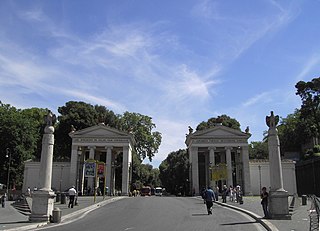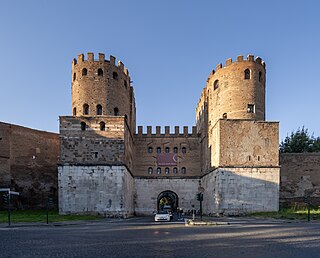
The Appian Way is one of the earliest and strategically most important Roman roads of the ancient republic. It connected Rome to Brindisi, in southeast Italy. Its importance is indicated by its common name, recorded by Statius, of Appia longarum... regina viarum . The road is named after Appius Claudius Caecus, the Roman censor who, during the Samnite Wars, began and completed the first section as a military road to the south in 312 BC.
Marcus Valerius Messalla Corvinus was a Roman general, author, and patron of literature and art.

Luigi Canina was an Italian archaeologist and architect.

The pyramid of Cestius is an ancient Roman pyramid in Rome, Italy, near the Porta San Paolo and the Protestant Cemetery. It was built in the style of the Nubian pyramids as a tomb for Gaius Cestius, a member of the Epulones religious corporation. It stands at a fork between two ancient roads, the Via Ostiensis and another road that ran west to the Tiber along the approximate line of the modern Via Marmorata. Due to its incorporation into the city's fortifications, it is today one of the best-preserved ancient buildings in Rome.

The Circus of Maxentius is an ancient structure in Rome, Italy, part of a complex of buildings erected by emperor Maxentius on the Via Appia between AD 306 and 312. It is situated between the second and third miles of the Via Appia, between the basilica and catacombs of San Sebastiano and the imposing late republican tomb of Caecilia Metella, which dominates the hill that rises immediately to the east of the complex. It is part of the Appian Way Regional Park.

The Porta San Sebastiano is the largest and one of the best-preserved gates passing through the Aurelian Walls in Rome (Italy).

The Caffarella Park is a large park in Rome, Italy, protected from development. It is part of the Parco Regionale Appia Antica. The park is contained in the Caffarella Valley and is bordered on its northern side by the Via Latina and on its southern by the Appian Way. It stretches from the main Rome-Pisa railroad tracks near the Aurelian Wall at its western edge to the Via dell'Almone to the east. It contains several sites of archaeological interest, as well as a working farm, and has considerable ecological value, with 78 species of birds and fauna. The Catacombs of Rome and Colli Albani are nearby.

The Tomb of the Scipios, also called the hypogaeum Scipionum, was the common tomb of the patrician Scipio family during the Roman Republic for interments between the early 3rd century BC and the early 1st century AD. Then it was abandoned and within a few hundred years its location was lost.

The Tomb of Caecilia Metella is a mausoleum located just outside Rome at the three mile marker of the Via Appia. It was built during the 1st century BC to honor Caecilia Metella, who was the daughter of Quintus Caecilius Metellus Creticus, a consul in 69 BC, and the wife of Marcus Licinius Crassus who served under Julius Caesar and was the son of the famous triumvir with the same name, Marcus Licinius Crassus. The mausoleum was probably built in 30–10 BC by her son who also had the same name, Marcus Licinius Crassus.

The Mausoleum of Helena is an ancient building in Rome, Italy, located on the Via Casilina, corresponding to the 3rd mile of the ancient Via Labicana. It was built by the Roman emperor Constantine I between 326 and 330, originally as a tomb for himself, but later assigned to his mother, Helena, who died in 330.

The Tomb of Hilarus Fuscus(Latin: Hilarus Fuscus or Hilarius Fuscus) is a funerary monument located near the fourth mile of the Appian Way or Via Appia Antica, to the southeast of Rome.

The Tomb of Priscilla is a monumental tomb erected in the first century in Rome on the Appian Way, situated opposite the Church of Domine Quo Vadis.

The Villa dei Sette Bassi was the second-largest ancient Roman villa or monumental palace in the suburbs after the Villa of the Quintilii.

The Appian Way Regional Park is the second-largest urban park of Europe, after Losiny Ostrov National Park in Moscow. It is a protected area of around 4580 hectares, established by the Italian region of Latium. It falls primarily within the territory of Rome but parts also extend into the neighbouring towns of Ciampino and Marino. The peculiarity of the park that distinguishes it, is that it also hosts the Archaeological park of Appia Antica, which coincides with the perimeter of the regional park itself. It is a monumental park which contains precious legacies of ancient Rome, including the Appian Way, various Roman aqueducts, Roman villas, mausoleums, catacombs.

The Catacombs of San Sebastiano are a hypogeum cemetery in Rome, Italy, rising along Via Appia Antica, in the Ardeatino Quarter. It is one of the very few Christian burial places that has always been accessible. The first of the former four floors is now almost completely destroyed.

The Mausoleum of Maxentius was part of a large complex on the Appian Way in Rome that included a palace and a chariot racing circus, constructed by the Emperor Maxentius. The large circular tomb was built by Maxentius in the early 4th century, probably with himself in mind and as a family tomb. When his young son Valerius Romulus died, he was buried there. After extensive renovation the mausoleum was reopened to the public in 2014.

A tholos, in Latin tholus, is a form of building that was widely used in the classical world. It is a round structure with a circular wall and a roof, usually built upon a couple of steps, and often with a ring of columns supporting a conical or domed roof.

Municipio Roma VII is the seventh administrative subdivision of the Municipality of Rome (Italy).

The Villa of Maxentius is an imperial villa in Rome, built by the Roman emperor Maxentius. The complex is located between the second and third miles of the ancient Appian Way, and consists of three main buildings: the palace, the circus of Maxentius and the dynastic mausoleum, designed in an inseparable architectural unit to honor Maxentius.




















